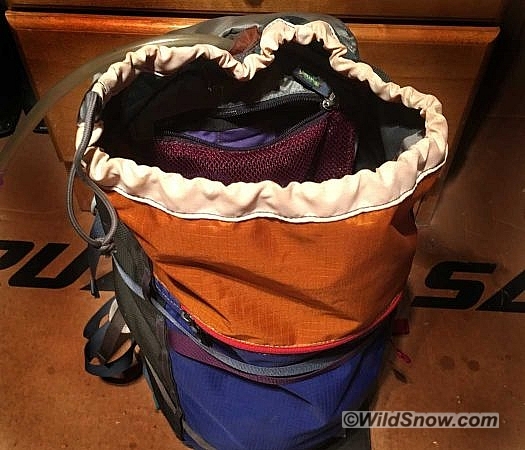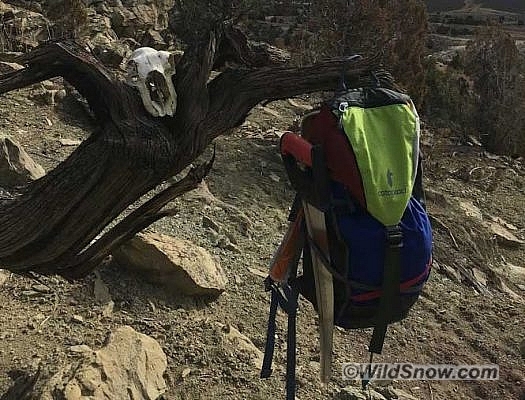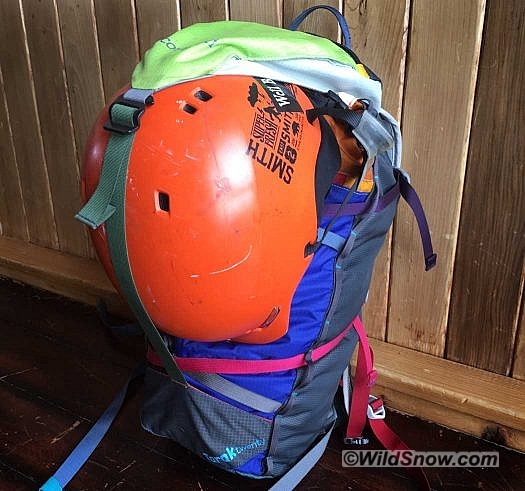
The 20L Tarak hit a sweet spot both in size and price, but it was the glorious riot of color in the Del Dia option that sold me. The Del Dia series are composed of leftover remnants of fabric from other production runs, with the final combination being left up to the employee sewing it together.
As a neophyte to the world of ski touring, I had been re-purposing gear from my trail building and mountain biking collections — with less-than satisfactory results. My trail building pack was way too large for my slack-country missions, and the hydration pack that served me so well on local summer mountain bike laps was stuffed to overflowing with the extra layers and gear that ski touring necessitates even on short yo-yo laps.
Balancing the ethical, and the affordable in gear selection is just as much a crux as choosing between technical performance, and minimalism. The production ethics of the gear we use to go play outdoors highlights a First World moral problem: How does one enjoy the peace and tranquility of the outdoors if the gear you are relying on was created by exploited labor? Cotopaxi offers a solution to this dilemma by offering clothing and bags sustainably sourced at a price point for working class recreationalists.
At a retail of less than $100, Tarak 20L from Cotopaxi hit a sweet spot between utility and minimalism that surprised me. Multitudes of pockets and compartments are how I usually prefer my packs, but I soon came to appreciate the “just enough” design, which gives it a broad-ranging utility. It is not a ski-touring specific pack, so it doesn’t have a separate compartment for avy gear or shovels, but the basic layout made it handy for packing a few extra layers, and additional food and water while still having space for miscellaneous storage.

A zippered mesh pocket inside the main compartment acts as the cover flap for the hydration sleeve, and provides storage space for snacks or tools. A sleeve is provided for a hydration bladder, but no insulation for the hose. I used an Osprey bladder with a formed reservoir to give the pack enough shape and support to stand up more readily while accessing the main compartment. Using a simple slit-style bite valve avoided some of the freezing issues that beset more complicated on/off valves.
The elegant simplicity of the drawstring main compartment and pocket top lid made me realize how much of my life I had wasted in frustration at trying to get zippers around curved openings. It provides quick and fumble-free opening and closing even with bulky gloves; and as the hook and webbing loop cinches down the top lid, it automatically compresses the pack when adding or removing layers of clothing, or stowing skins.

I never had occasion to use the ice ax carry, but the compression straps worked great as a saw carry.
Now into my second season with the Tarak 20L, I’ve found it to be a simple, and functional piece of gear that adapts well to mellow ski touring, day hikes, and longer mountain bike rides. The bright colors are just as endearing to me as their “Gear for Good” ethic, and the utility of the basic design gives it a broad-ranging versatility.
(Guest blogger Aaron Mattix grew up in Kansas and wrote a report on snowboarding in seventh grade. His first time to attempt snowboarding was in 2012, and soon switched over to skis for backcountry exploration near his home in Rifle, CO. His skill level is “occasionally makes complete runs without falling.” In the summer, he owns and operates Gumption Trail Works, building mountain bike singletrack and the occasional sweet jump.)
Aaron Mattix grew up in Kansas and wrote a report on snowboarding in seventh grade. His first time to attempt snowboarding was in 2012, and soon switched over to skis for backcountry exploration near his home in Rifle, CO. From snow covered alleys to steeps and low angle meadows, he loves it all. In the summer, he owns and operates Gumption Trail Works, building mountain bike singletrack and the occasional sweet jump.

